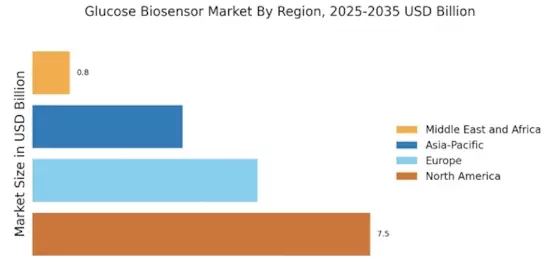The Glucose Biosensor Market is currently characterized by a dynamic competitive landscape, driven by technological advancements and increasing demand for diabetes management solutions. Key players such as Abbott Laboratories (US), Dexcom (US), and Roche Diagnostics (CH) are at the forefront, each adopting distinct strategies to enhance their market presence. Abbott Laboratories (US) focuses on innovation, particularly with its FreeStyle Libre system, which has revolutionized continuous glucose monitoring. Meanwhile, Dexcom (US) emphasizes partnerships with digital health platforms to integrate its biosensors into broader health management ecosystems. Roche Diagnostics (CH) is leveraging its extensive distribution network to expand its reach in emerging markets, thereby enhancing accessibility to its glucose monitoring solutions.
In terms of business tactics, companies are increasingly localizing manufacturing to reduce costs and improve supply chain efficiency. The market appears moderately fragmented, with several players vying for market share, yet the collective influence of major companies like Abbott and Dexcom is significant. Their strategies not only shape competitive dynamics but also set benchmarks for innovation and customer engagement within the industry.
In August 2025, Abbott Laboratories (US) announced a strategic partnership with a leading telehealth provider to enhance remote patient monitoring capabilities. This collaboration is poised to facilitate real-time data sharing between patients and healthcare providers, potentially improving diabetes management outcomes. The strategic importance of this move lies in its alignment with the growing trend towards telehealth, which is increasingly becoming a critical component of chronic disease management.
In September 2025, Dexcom (US) launched its latest generation of continuous glucose monitoring systems, which feature advanced algorithms for more accurate readings. This product release not only reinforces Dexcom's commitment to innovation but also positions the company to capture a larger share of the market as consumers seek more reliable and user-friendly solutions. The introduction of this technology is likely to enhance patient adherence to monitoring regimens, thereby improving overall health outcomes.
In July 2025, Roche Diagnostics (CH) expanded its product line by introducing a new glucose biosensor designed specifically for pediatric patients. This strategic move reflects Roche's commitment to addressing the unique needs of younger patients and their families, potentially opening new market segments. By tailoring products to specific demographics, Roche aims to differentiate itself in a competitive market, thereby enhancing its brand loyalty and market penetration.
As of October 2025, the Glucose Biosensor Market is witnessing trends such as digitalization, sustainability, and the integration of artificial intelligence in product development. Strategic alliances are increasingly shaping the competitive landscape, as companies recognize the value of collaboration in enhancing technological capabilities and market reach. Looking ahead, competitive differentiation is likely to evolve from traditional price-based strategies to a focus on innovation, technological advancements, and supply chain reliability, as companies strive to meet the growing expectations of consumers and healthcare providers.


















Leave a Comment